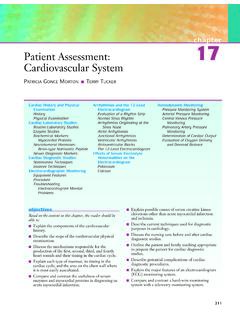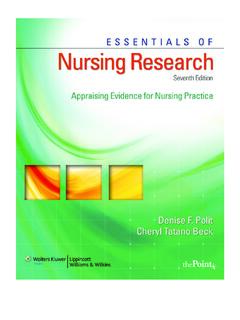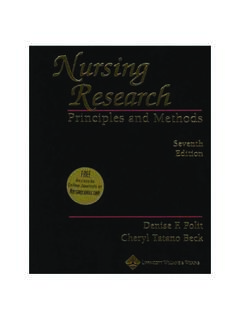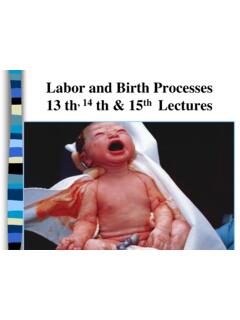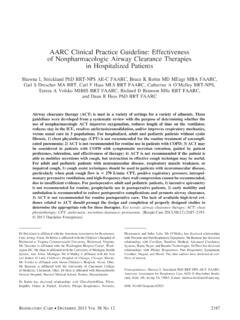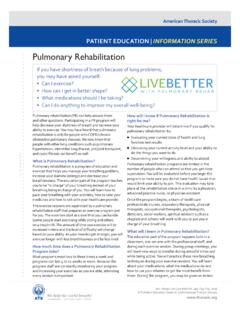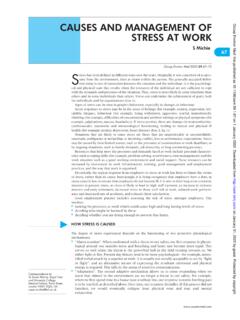Transcription of Postpartum assessment and nursing care - Al al-Bayt …
1 Postpartum assessment and nursing care Low & high risk 18th & 19th Lectures The Puerperium ( Postpartum Period) Begins immediately after childbirth and lasts for approximately six weeks, or until the body has completed its adjustment to a state of non pregnancy(both physically and psychologically). Maternal changes period: 1. Retrogressive: involution of the uterus and vagina 2. Progressive: -Production of milk and lactation -Restoration of normal menstrual cycle -Beginning of parenting Newborn Infants need Acceptance of Sex, Appearance, Size Recognition by the country (vital registration system Mother s need Information/counseling on What happens in their bodies including signs of possible problems Self care/hygiene and healing Nutrition Sexual Life Care of the baby and breastfeeding Contraception 4 Goal of Postpartum care Assist and support the woman s recovery.)
2 Assess and identify deviations from the norm & educate the mother about her own self care and infant care During the fourth stage of labor the woman is closely observed for hemorrhage and hypovolemic shock After the initial dangers of hemorrhage and shock have passed the primary Postpartum danger is infection Psychological Changes of the Postpartal Period taking-in phase : during 2- to 3-day period, the woman is largely passive. Woman usually wants to talk about her pregnancy (Reflection), especially about her labor and birth. She prefers having a nurse make decisions for her. Women's need at this time her to talk about the birth helps her integrate it into her life experiences, Not receptive to teaching at this time the taking-in phase, she rests to regain her physical strength and to calm and contain her swirling thoughts.
3 Anticipatory stage: looks to role models 2. The taking-hold phase From 3-10 day. The mother assumes more responsibility and is more independent about herself and her infant once her basic needs have been met. Ready to receive health teaching and info. Women's need at this time Give a woman brief demonstrations of baby care and then allow her to care for her child herself Women who give birth without any anesthesia may reach this second phase in a matter of hours after birth. (also Rooming-In ) Formal stage: influenced by the guidance of others 3. The letting-go phase The mother begins to view the infant as a separate person. Some mothers have a difficult time with this concept and psychological problems can occur if this is not resolve.
4 Roles may become disorganized relating to infant rearing, homemaking, and career Informal ( Personal) stage : woman starts to make her own decisions and done what she is comfortable with. Maternal Concerns and Feelings in the Postpartal Period Abandonment (Only hours before, they were the center of attention. Now, suddenly, the baby seems to be everyone's chief interest. Disappointment: It can be difficult for parents to feel positive immediately about a child who does not meet their expectations. Postpartal Blues (The syndrome is evidenced by tearfulness, mood sweening, anorexia, and sleep disturbance. Reassure a woman and her support person that sudden crying episodes are normal).)
5 It is also important to give the woman a chance to verbalize her feelings Physiologic Changes The Circulatory System Cardiac output is 60% to 80% higher than prelabor levels and remains elevated for at least 48 hours after delivery as a result to: pressure of the pregnant uterus is eliminated, lead to increased blood return to the vena cava. The blood that supplied the uteroplacental vascular bed goes back into the systemic circulation. The rapid reduction in the size of the uterus causes a decrease in systemic vascular resistance. The blood volume has returned to its normal prepregnancy level by the first or second week after birth. Usual blood loss with a vaginal birth is 300 to 500 mL.
6 With a cesarean birth, it is 500 to 1,000 mL. Vital Sign Changes Temperature: First 24 hours: slight increase related to dehydration during labor After 24 hours a rise of above 38 degrees is febrile. A Postpartum infection is suspected. On the 3rd to 4th day: a rise for a period of hours because of breasts filling with milk. If it lasts more it is suspicious of Postpartum infection. Pulse: Usually decreases to the end of Ist week. Tachycardia over 100 indicate hypovolemic shock, fever, anxiety, pain, excitement, or physical exertion or medication Blood pressure: Remain normal the first 24 hours after delivery. Orthostatic hypotension is caused fainting on the client s first ambulation, it is important to evaluate her stability.
7 Respiratory rate usually will remain normal The Hormonal Changes & Menstrual Cycle:- Pregnancy hormones begin to decrease as soon as the placenta is no longer present. By week1, progestrone are at pre pregnancy levels. Follicle-stimulating hormone (FSH) remains low for about 12 days and then begins to rise as a new menstrual cycle is initiated. A woman who is not breast -feeding can expect her menstrual flow to return in 6 to 10 weeks after birth. If she is breast -feeding, menstrual flow may not return for 3 or 4 months (lactational amenorrhea) or, in some women, for the entire lactation period. The Integumentary System After birth, the stretch marks on the woman's abdomen (striae gravidarum) still appear reddened and may be even more prominent than during pregnancy, when they were tightly stretched.
8 Excessive pigment on the face and neck (chloasma) and on the abdomen ( linea nigra) will become barely detectable in 6 Weeks' time. If diastasis recti (over stretching and separation of the abdominal musculature) is present, the area will appear slightly indented. The Urinary System During pregnancy, as much as 2,000 to 3,000 mL excess fluid accumulate in the body. An extensive diuresis begins to take place almost immediately after birth to rid the body of this fluid. Pressure during vaginal birth may leave the bladder with a transient loss of tone that, together with the edema surrounding the urethra, decreases a woman's ability to sense when she has to void.
9 Diaphoresis (excessive sweating) is another way by which the body rids itself of excess f luid. This is noticeable in women soon after birth. The Gastrointestinal System Digestion and absorption begin to be active again soon after birth. Almost immediately, the woman feels hungry and thirsty because of the long period of restricted fluid during labor and the beginning diaphoresis. Hemorrhoids (distended rectal veins) that have been pushed out of the rectum due to the effort of pushing often are present. Bowel sounds are active , but passage of stool through the bowel may be slow because of the still-present effect of relaxin on the bowel.
10 Bowel evacuation may be difficult due to the pain of episiotomy sutures or hemorrhoids. Postpartum nursing assessment Done twice a day until discharge. The nurse must explain what is happening and what the mother can expect. At all times, The nurse maintains the mother s privacy. Hand washing precedes any assessment & use nonsterile gloves and universal precautions to prevent contact with blood and other body fluids, including breast milk. assessment Bubble B Breasts U Uterus B Bladder B Bowel L Lochia E Epistomy/Extremities 16 Immediately following delivery of the baby, the new mother s breasts produce colostrum, a thin yellowish fluid that contains extra calories and protein, as well as important antibodies Colostrum is usually secreted for 2 to 3 days after birth and is then replaced by the mother s breast milk Breastfeeding requires the mother to take in extra calories and fluids The woman s breasts may become swollen and painful when the milk comes in Frequent nursing of the infant will help to ease the discomfort.




